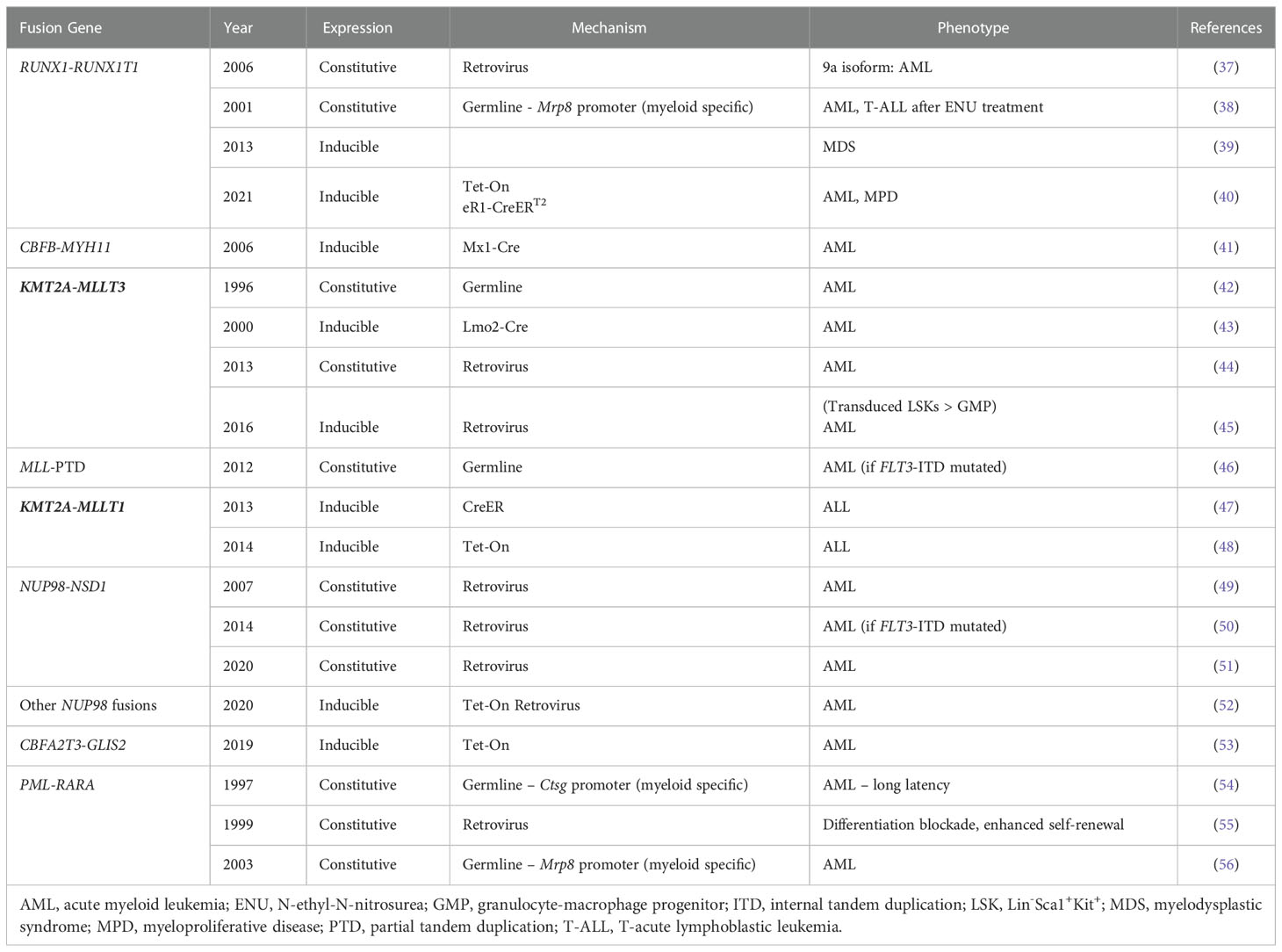Murine Models of Acute Myeloid Leukemia
- 1Department of Pediatrics, Baylor College of Medicine, Texas Children’s Hospital, Houston, TX, United States
- 2Department of Molecular and Cellular Biology, Baylor College of Medicine, Houston, TX, United States
A corrigendum on
Murine models of acute myeloid leukemia
by Kurtz KJ, Conneely SE, O’Keefe M, Wohlan K and Rau RE (2022). Front. Oncol. 12:854973. doi: 10.3389/fonc.2022.854973
In the original article, there was an error in Table 1 as published. We inadvertently omitted a CBFA2T3-GLIS2 mouse model and two NUP98 fusion models. The corrected Table 1 and its caption appear below.
Text Correction
In the original article, several sections were mislabeled. The sub-section titled “Core binding factor leukemias” currently is labeled with “4”. This has been corrected to 3.1.
The sub-section titled “NUP98 Fusions” currently is labeled as section 3.4. This has been corrected to 3.3.
Missing reference
In the sub-section “NUP98 Fusions”, we failed to reference an important paper, Wang et al., 2007.
We have therefore inserted a new sentence and modified a sentence in that section.
Original text: Retroviral models of NUP98 fusions have served as the predominant mouse models to date. Mohanty et al. showed that retroviral model of NUP98-NSD1, the most common NUP98 fusion in pediatric AML, into murein HSCs followed by transplantation independently produced AML with a median survival of 250 days post-transplant with significant disease acceleration when NRASG12D is co-expressed.
Corrected text:
Retroviral models of NUP98 fusions have served as the predominant mouse models to date. In 2007 Wang et al. showed that retroviral transduction of NUP98-NSD1, the most common NUP98 fusion in pediatric AML, into murine hematopoietic progenitors followed by transplantation independently produced AML with an average survival of 126 days post-transplant (68). Mohanty et al. created a similar retroviral model of NUP98-NSD1 and demonstrated significant disease acceleration when NRASG12D is co-expressed.
Text correction
In the sub-section, “CBFA2T3-GLIS2” we originally did not include an important mouse model reported by Lopez, et al. The corrected text appears below.
Lopez et al. (53) developed a novel transgenic model using tetracycline-inducible expression of CBFA2T3-GLIS2 in which nearly all mice developed a lethal hematologic malignancy, 20% of which displayed megakaryoblastic markers with a disease latency of 164 days, whereas the remaining mice displayed heterogeneous non-megakaryoblastic immunophenotypes with a significantly longer disease latency (79). As this fusion is predominantly found in pediatric AML, the authors sought to investigate the role of developmental stage on leukemia onset. They found that transplantation of fetal liver cells from their inducible model led to a shorter disease latency with a predominant megakaryoblastic population compared to mice transplanted with bone marrow from adult mice, demonstrating that developmental stage significantly impacts disease phenotype. The Lopez et al. transgenic model was a substantial technical advancement as prior to its description, murine models had been largely limited to patient-derived xenografts (PDXs) (80).
The authors apologize for these errors and state that they do not change the scientific conclusions of the article in any way. The original article has been updated.
Publisher’s note
All claims expressed in this article are solely those of the authors and do not necessarily represent those of their affiliated organizations, or those of the publisher, the editors and the reviewers. Any product that may be evaluated in this article, or claim that may be made by its manufacturer, is not guaranteed or endorsed by the publisher.
Keywords: acute myeloid leukemia, AML, transgenic mouse, genetically engineered mice (GEM), core binding factor acute myeloid leukemia, KMT2a (MLL) rearrangements, NUP98 fusion, patient-derived xenograft (PDX)
Citation: Kurtz KJ, Conneely SE, O’Keefe M, Wohlan K and Rau RE (2023) Corrigendum: Murine models of acute myeloid leukemia. Front. Oncol. 12:1089874. doi: 10.3389/fonc.2022.1089874
Received: 04 November 2022; Accepted: 13 December 2022;
Published: 23 February 2023.
Edited and Reviewed by:
Paraskevi Panagopoulou, Aristotle University of Thessaloniki, GreeceCopyright © 2023 Kurtz, Conneely, O’Keefe, Wohlan and Rau. This is an open-access article distributed under the terms of the Creative Commons Attribution License (CC BY). The use, distribution or reproduction in other forums is permitted, provided the original author(s) and the copyright owner(s) are credited and that the original publication in this journal is cited, in accordance with accepted academic practice. No use, distribution or reproduction is permitted which does not comply with these terms.
*Correspondence: Rachel E. Rau, Rachel.rau@bcm.edu
†These authors contributed equally to this work
 Kristen J. Kurtz1†
Kristen J. Kurtz1† Shannon E. Conneely
Shannon E. Conneely Rachel E. Rau
Rachel E. Rau